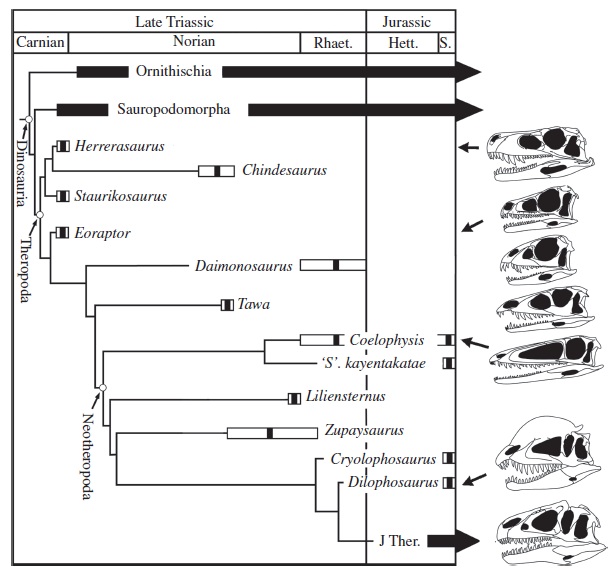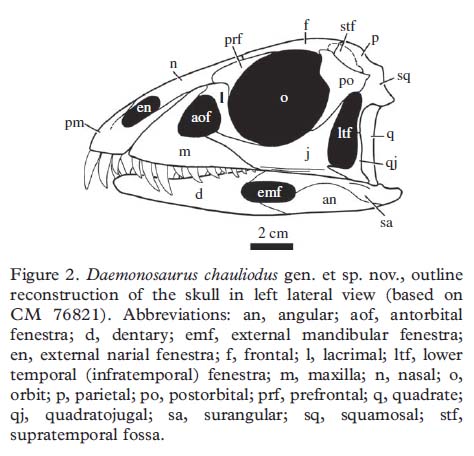
| Palaeos |  |
Theropoda |
| Vertebrates | Basal Theropods |
| Page Back | Unit Home | Unit Dendrogram | Unit References | Taxon Index | Page Next |
| Unit Back | Vertebrates Home | Vertebrate Dendrograms | Vertebrate References | Glossary | Unit Next |
|
Abbreviated Dendrogram
DINOSAURIA |--ORNITHISCHIA `--+--SAUROPODOMORPHA | `--THEROPODA |--Herrerasauridae `--+--Eoraptor `--+--Daemonosaurus `--+--Tawa `==Podokesauridae `--+--Ceratosauria `--Tetanurae `--Avetheropoda |--Carnosauria `==COELUROSAURIA `--AVES |
Contents
Index |
 Early theropod evolution, from Sues et al 2011. Ages of fossils are denoted by black bars. This topology presents Herrerasaurs and Eoraptor as basal theropods copied from Smithsonian Com |
The general theropod condition - a medium sized, lightly built, fast-running bipedal predator - seem to represent the plesiomorphic condition not only for saurischia but even for dinosaurs as a whole, as indicated by the ambiguous status of taxa such as late Carnian and early Norian taxa such as Eoraptor, Herrerasaurus, Staurikosaurus, Chindesaurus, Guaibasaurus, and Eodromaeus, which stand at the dawn of theropod and indeed dinosaurian evolution. It is not hard to see how bipedal protodinosaurs could have given rise to these animals. In this way, other lines of dinosaurs may have successively arisen from prototheropod ancestors, through reversals and loss of early theropod attributes, and acquiring of new ones. It is interesting also that with the classic proto-theropod Eoraptor we find a move to omnivory, also characterises the earliest sauropodomorphs (prosauropods).
By the time we get to the middle Norian to Rhaetian, the theropod condition is unambigiously established. Here the newly discovered and described transitional genera Daemonosaurus and Tawa bridge the morphological gap between these earlier forms and bird-like theropods (neotheropoda or avepoda). They constitute the intermediate links between the first pulse or wave of theropod evolution, consisting of primitive types like Eoraptor and the Herrerasaurs, and the second, represented by the earliest three-toed neotheropods, the podokesaurs. It was these latter animals, beginning with little Coelophysis and its cousins (representing a third stage of theropod evolution), that would set the standard that would define theropod dinosaurs for the rest of the Mesozoic, and which would in the late Jurassic give rise to the most succesful of all the dinosaurian clades, the birds.
As shown by the chronogram at the right, even Triassic theropods and prototheropods were a diverse assemblage, with a number of lineages evolving in parallel during the Norian, although only the neotheropods would continue through to the early Jurassic and beyond. MAK120207
Eoraptor lunensis Sereno et al., 1993
Range: Carnian of SAm
Phylogeny: basal Theropoda or basal Saurischia; we are using Theropoda : Herrerasauridae + ((Daemonosaurus + (Tawa + Neotheropoda)) + *) but alternative hypotheses would be just as valid, although it is agreed that Eoraptor is more basal than Daemonosaurus or Tawa.
Comments: one of the earliest and most primitive dinosaurs. Although most commonly interpreted as a basal theropod more primitive than herrarasaurs (Sereno et al 1993, Novas 1997) or more derived than them (Nesbitt et al 2009, Ezcurra 2010, Nesbitt 2011, Sues et al 2011), it has also been interpreted as a stem saurischian more basal than (, Upchurch et al 2007) or more advanced than herrerasaurs (Langer 2004, Yates 2005, Yates 2007, Apaldetti et al 2011), and even a basal sauropodomorph (Martinezetal2011, substituting Eodromaeus in Eoraptor's old station as basal theropod). Strangely for such an early theropod, and unlike most of its contemporaries, Eoraptor is thought to have been omnivorous; if true this would support either an omnivorous ancestry for the dinosaurs, or a proto-sauropodomorph phylogeny (i,.e. either it is in the process of evolving away from, or towards, omnivory), or both. The name, which means 'dawn plunderer from the Valley of the Moon', denotes where it was originally discovered (the badlands where the Ischigualasto formation outcrops, known as Valle de la Luna ("Valley of the Moon") due to their arid, otherworldly appearance - Wikipedia). Emphasising the arbitrary line between theropod and basal sauruischian, we have retained Eoraptor as the most primitive known theropod here, although it could just as easily be placed among the basal dinosauria. MAK120207
 The holotype skull of Daemonosaurus, from Sues et al 2011 copied from Dino Paradise (in Japanese) |
Daemonosaurus chauliodus Sues et al., 2011
Horizon: latest Triassic siltstone member of the Chinle Formation of the Coelophysis Quarry at Ghost Ranch, New Mexico - Rhaetian
Phylogeny: Theropoda : Herrerasauridae + (Eoraptor + ( (Tawa + Neotheropoda) + *))
Size: length about 1.5 m long.
Comments: Known from a skull, some vertebrae, and ribs collected from the Ghost Ranch quarry in the 1980s. Fossils of Coelophysis were present on the same block that contained the skull of Daemonosaurus. The skull is remarkable for its short snout and large premaxillary and maxillary teeth in the upper jaw. Teeth projecting forward from the tips of the upper and lower jaws give it a buck-toothed appearance (which is what the species name chauliodis roughly means). May or may not be a juvenile. Phylogenetic analysis reveals Daemonosaurus to be more closely related to coeval neotheropods (e.g. Coelophysis bauri) than to Herrerasauridae and Eoraptor. Closely related to, but apparently even more primitive, than Tawa, the two bridging the morphological gap between Herrerasaurs and neotheropods (Sues et al 2011). This animal is remarkable for its unusually short (by Triassic theropod standards) snout (reminiscent of early prosauropod and ornithschian herbivores); all other early theropods had long heads and jaws. David Peters suggests that it is actually the most basal member of the Phytodinosauria, a clade proposed by Robert T. Bakker his Dinosaur Heresies in the 1980s. Bakker rejected the Saurischia-Ornithschia divide and instead placed the theropods in their own group and the sauropodomorphs and ornithischians in another, with the segnosaurs intermediate between the two. As it is now known that the segnosaurs are actually theriznosaur theropods closely related to birds, and most phytosaur characteristics can be explained in terms of convergences the hypothesis has long fallen out of favour (See a 2001 discussion re Phytodinosauria on the Dinosaur Mailing List).
Links: Paleoexhibit - Nobu Tamura, Wikipedia, Smithsonian Com, Theropods blog MAK120206

Tawa hallae, Nesbitt et al 2009
Horizon: Hayden Quarry, Ghost Ranch, Rio Arriba County, New Mexico, in the lower portion of the Petrified Forest Member Ghost Ranch in New Mexico (~215 to 213 mya) - Middle Norian
Phylogeny: Theropoda : Herrerasauridae + (Eoraptor + (Daemonosaurus + (Neotheropoda + *)))
Comments: named after the Hopi sun god, this newly discovered theropod dinosaur described by Sterling Nesbitt and co-workers is known from several remarkably well preserved and nearly complete skeletons, which reveal a mosaic of plesiomorphic and derived features. Cladistic analysis reveals it to be more basal than Coelophysis and the sister taxon of Neotheropoda. . It also shows that "Coelophysoidea" is probably an artificial grouping because Tawa combines classic coelophysoid (podokesaur) with basal theropod characteristics. Shares with coelophysoids a kink between the maxilla and the premaxilla, and a longer-necked, slender build which distinguishes it from earlier forms such as Herrerasaurs and Eoraptor. Tawa's intermediate characteristics between Herrerasaurs and Coelophysis also argues for the formers' inclusion under the theropoda (Nesbitt et al 2009). The animal was about 2 m long, average for Triassic theropods and proto-theropods. The specific name honours Ruth Hall, founder of the Ghost Ranch Museum of Paleontology.
Links: Tawa hallae - National Science Foundation coverage best on the web; Paleoblog; Wikipedia MAK120207
Image: Tawa hallae skeleton. Sterling Nesbitt, National Science Foundation
| Page Back | Unit Home | Page Top | Page Next |
checked ATW030913, modified MAK120207